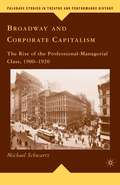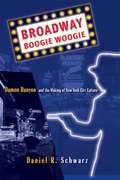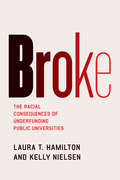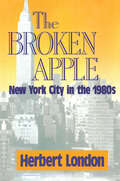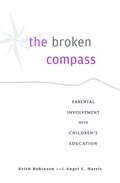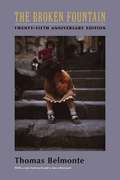- Table View
- List View
Broadening the Horizons of Chinese History: Discourses, Syntheses and Comparisons
by Ray HuangGathered here are research papers, speeches, and lecture notes, a multifaceted survey of Chinese history embracing a wide range of subjects, from historical antecedents, relevant Western experience, and recent revelations to locus classicus and statistics. All lead to Huang's grand synthesis: That the one-and-a-half-century-long Chinese revolution is nearing fulfillment as Chinese civilization merges with Western history. While not everyone will agree with Ray Huang, no one who is seriously concerned with these issues can afford to ignore the provocative and erudite challenge of his vision.
Broadening the Horizons of Chinese History: Discourses, Syntheses and Comparisons
by Ray HuangGathered here are research papers, speeches, and lecture notes, a multifaceted survey of Chinese history embracing a wide range of subjects, from historical antecedents, relevant Western experience, and recent revelations to locus classicus and statistics. All lead to Huang's grand synthesis: That the one-and-a-half-century-long Chinese revolution is nearing fulfillment as Chinese civilization merges with Western history. While not everyone will agree with Ray Huang, no one who is seriously concerned with these issues can afford to ignore the provocative and erudite challenge of his vision.
Broadlands and the New Rurality: An Ethnography (Emerald Points)
by Sam HillyardIn this ethnographic study of the rural idyll, Broadlands explores rurality and the pace of rural life. In sharp contrast to the urban analytical emphasis upon speed, it gives careful thought to stasis, as rural places offer everyday opportunities for very different social situations and behavioural interactions. Based on new and extensive RCUK-funded primary research, Sam Hillyard generates an original, rigorous and thoughtful understanding of everyday rural life in the 21st century. Taking the principles of dramaturgy and rural studies scholarship, Broadlands provides a toolkit to make sense of rural change. It uses ethnography to enhance interactionist dramaturgy via cross-references with new theoretical orientations that emphasise the temporal dynamics of space in a 'knowing capitalism'. Where early dramaturgy stressed formal organisations in shaping roles and identity, Broadlands expands these concepts to include informal and transient organisations and associations. Ultimately, the book advances a new model for grasping the complexity of the rural. For researchers and students ofrural and urban sociology, this is an engaging text that reframes our understanding of rurality.
Broadlands and the New Rurality: An Ethnography (Emerald Points)
by Sam HillyardIn this ethnographic study of the rural idyll, Broadlands explores rurality and the pace of rural life. In sharp contrast to the urban analytical emphasis upon speed, it gives careful thought to stasis, as rural places offer everyday opportunities for very different social situations and behavioural interactions. Based on new and extensive RCUK-funded primary research, Sam Hillyard generates an original, rigorous and thoughtful understanding of everyday rural life in the 21st century. Taking the principles of dramaturgy and rural studies scholarship, Broadlands provides a toolkit to make sense of rural change. It uses ethnography to enhance interactionist dramaturgy via cross-references with new theoretical orientations that emphasise the temporal dynamics of space in a 'knowing capitalism'. Where early dramaturgy stressed formal organisations in shaping roles and identity, Broadlands expands these concepts to include informal and transient organisations and associations. Ultimately, the book advances a new model for grasping the complexity of the rural. For researchers and students ofrural and urban sociology, this is an engaging text that reframes our understanding of rurality.
Broadway [2 volumes]: An Encyclopedia of Theater and American Culture [2 volumes]
by Thomas A. GreenfieldThis is the most comprehensive and insightful reference available on Broadway theater as an American cultural phenomenon and an illuminator of American life.Broadway: An Encyclopedia of Theater and American Culture is the first major reference work to explore just how much the "Great White Way" illuminates our national character. In two volumes spanning the era from the mid-19th century to the present, it offers nearly 200 entries on a variety of topics, including spotlights on 30 landmark productions—from Shuffle Along to Oklahoma! to Oh Calcutta! to The Producers—that not only changed American theater but American culture as well.In addition, Broadway offers thirty extended thematic essays gauging the powerful impact of theater on American life, with entries on race relations, women in society, sexuality, film, media, technology, tourism, and off-Broadway and noncommercial theater. There are also 110 profile entries on key persons and institutions—from the famous to the infamous to the all but forgotten—whose unique careers and contributions impacted Broadway and its place in the American landscape.
Broadway and Corporate Capitalism: The Rise of the Professional-Managerial Class, 1900–1920 (Palgrave Studies in Theatre and Performance History)
by M. SchwartzThrough an examination of plays, actors, reviews, and audience response of the period, this study traces the development of Broadway as a source of 'mature' American drama, and the simultaneous development of Professional-Managerial Class consciousness and habitus.
Broadway Boogie Woogie: Damon Runyon and the Making of New York City Culture
by D. SchwarzWhile analyzing Damon Runyon's high spirited work in terms of historical contexts, popular culture, and of the changing function of the media, Schwarz argues that in his columns and stories Runyon was an indispensable figure in creating our public images of New York City culture, including our interest in the demi-monde and underworld that explains in part the success of The Godfather films and The Sopranos . In his lively and exuberant chapters that include a panoramic view of New York City between the World Wars - with a focus on its colourful nightlife - Schwarz examines virtually every facet of Runyon's career from sports writer, daily columnist, trial reporter, and Hollywood figure to the author of the still widely-read short stories that were the source of the Broadway hit Guys and Dolls . As part of his discussion of Runyon's art and the artistry of Runyon's fiction, Schwarz skilfully examines the special language of the Broadway stories known as 'Runyonese', and explains how 'Runyonese' has become an adjective for describing flamboyant behaviour.
Brogdon's Forensic Radiology
by Michael J. Thali Mark D. Viner B. G. BrogdonThe benchmark first edition of Forensic Radiology, published in 1998, was a milestone in the forensic community — a bestseller throughout the world and a standard reference for practitioners and educators alike. Like its predecessor, Brogdon’s Forensic Radiology, Second Edition covers the entire scope of radiological applications in the forensic sciences, profiling current and anticipated uses of new modalities and techniques. Features: Provides an introduction to forensic radiology, including historical perspectives and definitions used in the field Offers instruction on trial preparation and effective courtroom testimony Demonstrates the use of forensic radiology in identification of the dead Explores the use of radiology to help in gunshot and abuse cases and in nonviolent crimes Contains an entirely new section on virtual imaging and virtopsy Examines technological and safety issues For radiologists, forensic scientists, forensic dentists, medical examiners, investigators, and attorneys Over the past twelve years, the fields of forensic science and radiology have developed considerably, necessitating a revision of this critical work. New Topics in this Edition include: The radiologist as an expert witness Modern cross-sectional imaging in anthropology New approaches to radiology in mass casualty situations The use of virtual imaging and virtopsy — new modalities developed and advanced since the publication of the last edition Forensic and clinical usage of x-rays in body packing for drug smuggling Imaging in the medical examiner’s facility and in the field Radiology of special objects, antiquities, and mummies
Broke: Who Killed The Middle Classes?
by David BoyleIf you thought being middle-class meant your own home, something set aside for the kids and a comfortable retirement – think again.
Broke: Fixing Britain’s poverty crisis
by Tom Clark“Drawing on the testimony of those trapped in the quicksand of poverty, Broke is a wake-up call for anyone who still thinks Britain is a fair or ‘civilised’ country.” – Darren McGarvey, BBC Reith lecturer, Orwell Prize winner and author of Poverty Safari “A devastating portrait of modern poverty, Broke is urgently reported and beautifully written, with humane and empathetic accounts of what it feels like to be caught in a 21st-century poverty trap. This collection of essays sets out in disturbing detail the true impact of a decade of austerity policies and should be required reading for politicians and policymakers.” – Amelia Gentleman, award-winning journalist and author of The Windrush Betrayal “I grew up at a time when poverty was rife but governments of right and left were committed to its eradication. Tom Clark conducts an orchestra of experts to demonstrate that poverty is rife once again and the only thing that’s been eradicated is government’s determination to deal with it.” – Alan Johnson, former Cabinet minister and author of the Orwell Prize-winning This Boy “We often find it uncomfortable to listen to the voices of those who struggle without enough. Broke refuses us the consolation of false innocence and shows us what sort of society we have become. We should be ashamed but also take heart from the steadfastness, solidarity and resistance revealed.” – Giles Fraser, Anglican priest and panellist of BBC’s Moral Maze *** A dozen years into austerity, statistical warning lights are flashing to suggest a return to types of deprivation we once imagined we had consigned to history. In the decade up to the pandemic, the official count of rough sleepers and recorded malnutrition in hospital patients both doubled, while recourse to food banks rocketed by an order of magnitude. And yet it has never been statistics but rather individual human stories – from the fictionalised accounts of Dickens to the faithful reporting of Orwell and Priestley – that have seared the reality of hard times into the public imagination. In Broke, Tom Clark assembles today’s masters of social reportage to go deep into the communities so often ignored by politicians, introducing us to those at the hardest end of the poverty crisis. Contributions from Jem Bartholomew, Cal Flyn, Dani Garavelli, Frances Ryan, Samira Shackle, Daniel Trilling and Jennifer Williams, and a foreword by Kerry Hudson, unflinchingly reveal the contemporary experience of cold, hunger, homelessness, disease, debt, disability, punishing work and an immigration system that makes people destitute by design. With Joel Goodman’s photography bringing the characters to life, and some of the writers having had first-hand experience of the issues raised, Broke blends powerful human stories with analysis of the policies that have led us to this point – and the reforms we urgently need. All royalties will be donated to Leeds Asylum Seekers’ Support Network
Broke: The Racial Consequences of Underfunding Public Universities
by Laura T. Hamilton Kelly NielsenPublic research universities were previously able to provide excellent education to white families thanks to healthy government funding. However, that funding has all but dried up in recent decades as historically underrepresented students have gained greater access, and now less prestigious public universities face major economic challenges. In Broke, Laura T. Hamilton and Kelly Nielsen examine virtually all aspects of campus life to show how the new economic order in public universities, particularly at two campuses in the renowned University of California system, affects students. For most of the twentieth century, they show, less affluent families of color paid with their taxes for wealthy white students to attend universities where their own offspring were not welcome. That changed as a subset of public research universities, some quite old, opted for a “new” approach, making racially and economically marginalized youth the lifeblood of the university. These new universities, however, have been particularly hard hit by austerity. To survive, they’ve had to adapt, finding new ways to secure funding and trim costs—but ultimately it’s their students who pay the price, in decreased services and inadequate infrastructure. The rise of new universities is a reminder that a world-class education for all is possible. Broke shows us how far we are from that ideal and sets out a path for how we could get there.
Broke: The Racial Consequences of Underfunding Public Universities
by Laura T. Hamilton Kelly NielsenPublic research universities were previously able to provide excellent education to white families thanks to healthy government funding. However, that funding has all but dried up in recent decades as historically underrepresented students have gained greater access, and now less prestigious public universities face major economic challenges. In Broke, Laura T. Hamilton and Kelly Nielsen examine virtually all aspects of campus life to show how the new economic order in public universities, particularly at two campuses in the renowned University of California system, affects students. For most of the twentieth century, they show, less affluent families of color paid with their taxes for wealthy white students to attend universities where their own offspring were not welcome. That changed as a subset of public research universities, some quite old, opted for a “new” approach, making racially and economically marginalized youth the lifeblood of the university. These new universities, however, have been particularly hard hit by austerity. To survive, they’ve had to adapt, finding new ways to secure funding and trim costs—but ultimately it’s their students who pay the price, in decreased services and inadequate infrastructure. The rise of new universities is a reminder that a world-class education for all is possible. Broke shows us how far we are from that ideal and sets out a path for how we could get there.
Broke: How Debt Bankrupts the Middle Class (Studies in Social Inequality #71)
by Katherine PorterAbout 1.5 million households filed bankruptcy in the last year, making bankruptcy as common as college graduation and divorce. The recession has pushed more and more families into financial collapse—with unemployment, declines in retirement wealth, and falling house values destabilizing the American middle class. Broke explores the consequences of this unprecedented growth in consumer debt and shows how excessive borrowing undermines the prosperity of middle class America. While the recession that began in mid-2007 has widened the scope of the financial pain caused by overindebtedness, the problem predated that large-scale economic meltdown. And by all indicators, consumer debt will be a defining feature of middle-class families for years to come. The staples of middle-class life—going to college, buying a house, starting a small business—carry with them more financial risk than ever before, requiring more borrowing and new riskier forms of borrowing. This book reveals the people behind the statistics, looking closely at how people get to the point of serious financial distress, the hardships of dealing with overwhelming debt, and the difficulty of righting one's financial life. In telling the stories of financial failures, this book exposes an all-too-real part of middle-class life that is often lost in the success stories that dominate the American economic narrative. Authored by experts in several disciplines, including economics, law, political science, psychology, and sociology, Broke presents analyses from an original, proprietary data set of unprecedented scope and detail, the 2007 Consumer Bankruptcy Project. Topics include class status, home ownership, educational attainment, impacts of self-employment, gender differences, economic security, and the emotional costs of bankruptcy. The book makes judicious use of illustrations to present key findings and concludes with a discussion of the implications of the data for contemporary policy debates.
Broke: Patients Talk about Money with Their Doctor
by Michael SteinIn this age of shortened office visits, doctors take care of their patients' immediate needs and often elide their own personal histories. But as reflected in Broke, Michael Stein takes the time to listen to the experiences of his patients whose financial challenges complicate every decision in life they make. Stein asks his patients to tell him about their financial conditions not only to find out how to better treat them but also to bear witness to their very survival and the power of human resilience. Stein's intimate vignettes capture these encounters, allowing his patients to offer profound, moving, and unguarded reflections about their struggles, sometimes in a single sentence. Broke is a quietly passionate critique of a country that has grown callous to the plight of the poor, the tens of millions of people in the United States who live below the poverty line and who have no obvious path to security. Full of heartbreaking and surprising details and framed by a wry, knowing, and empathic humor, there is no other book that illuminates the experience of people facing economic hardship in this way.
Broke and Patriotic: Why Poor Americans Love Their Country (Studies in Social Inequality)
by Francesco DuinaWhy are poor Americans so patriotic? They have significantly worse social benefits compared to other Western nations, and studies show that the American Dream of upward mobility is, for them, largely a myth. So why do these people love their country? Why have they not risen up to demand more from a system that is failing them? In Broke and Patriotic, Francesco Duina contends that the best way to answer these questions is to speak directly to America's most impoverished. Spending time in bus stations, Laundromats, senior citizen centers, homeless shelters, public libraries, and fast food restaurants, Duina conducted over sixty revealing interviews in which his participants explain how they view themselves and their country. He masterfully weaves their words into three narratives. First, America's poor still see their country as the "last hope" for themselves and the world: America offers its people a sense of dignity, closeness to God, and answers to most of humanity's problems. Second, America is still the "land of milk and honey:" a very rich and generous country where those who work hard can succeed. Third, America is the freest country on earth where self-determination is still possible. This book offers a stirring portrait of the people left behind by their country and left out of the national conversation. By giving them a voice, Duina sheds new light on a sector of American society that we are only beginning to recognize as a powerful force in shaping the country's future.
The Broken Apple: New York City in the 1980's
by Herbert I. LondonOn the brink of bankruptcy in the 1970s, New York City has been restored as a center of economic and cultural vitality in the 1980s. But it has also become an increasingly brutal place, where incivility reigns, drugs lace the streets, and crime is so pervasive that most New Yorkers now consider it a permanent fixture, like gray skies and impossible traffic. What is it that continues to draw people to this city of contradictions?Born and educated in New York, Herbert London knows this city of dreams as few do. The Broken Apple is based on his keen observations of New York's social, political, and cultural life over the critical decade of the 1980s. London examines the city's continuing failures, including a city administration unable to meet the most basic citizen needs or to assure safety and security. He sees schools that have become mean-spirited, with teachers unable to teach, administrators unable to maintain order, and students unable to learn. He describes the new slaves of New York as those in search of a place to live, in a city where housing is in shorter supply than in any other major city in the nation. London asks why, despite all this, everything is bigger than life in New York, and finds the answer in New York's role as the nation's communications hub and the measuring rod by which other cities are judged.London writes with knowledgeable affection about this very special place, where the mundane is freely converted into the metaphorical. His book is an excursion, a guide to what is good, what is bad, and what is awful in the city. It is a montage of the years of Mayor Koch, the period many have described as the city's fin de siecle. But it is also a perscriptive book, pointing out what can be done in practical ways to improve life.The Broken Apple will be of interest to urban specialists as well as those for whom New York is an aspiration or a reality. Like the city itself, the book has something for everyone, from visions of political corruption to acts of redemption. Above all, it captures the pulsating rhythm of this unique city
The Broken Apple: New York City in the 1980's
by Herbert I. LondonOn the brink of bankruptcy in the 1970s, New York City has been restored as a center of economic and cultural vitality in the 1980s. But it has also become an increasingly brutal place, where incivility reigns, drugs lace the streets, and crime is so pervasive that most New Yorkers now consider it a permanent fixture, like gray skies and impossible traffic. What is it that continues to draw people to this city of contradictions?Born and educated in New York, Herbert London knows this city of dreams as few do. The Broken Apple is based on his keen observations of New York's social, political, and cultural life over the critical decade of the 1980s. London examines the city's continuing failures, including a city administration unable to meet the most basic citizen needs or to assure safety and security. He sees schools that have become mean-spirited, with teachers unable to teach, administrators unable to maintain order, and students unable to learn. He describes the new slaves of New York as those in search of a place to live, in a city where housing is in shorter supply than in any other major city in the nation. London asks why, despite all this, everything is bigger than life in New York, and finds the answer in New York's role as the nation's communications hub and the measuring rod by which other cities are judged.London writes with knowledgeable affection about this very special place, where the mundane is freely converted into the metaphorical. His book is an excursion, a guide to what is good, what is bad, and what is awful in the city. It is a montage of the years of Mayor Koch, the period many have described as the city's fin de siecle. But it is also a perscriptive book, pointing out what can be done in practical ways to improve life.The Broken Apple will be of interest to urban specialists as well as those for whom New York is an aspiration or a reality. Like the city itself, the book has something for everyone, from visions of political corruption to acts of redemption. Above all, it captures the pulsating rhythm of this unique city
Broken Bodies, Places and Objects: New Perspectives on Fragmentation in Archaeology
by Anna Sörman Astrid A. Noterman Markus FjellströmBroken Bodies, Places and Objects demonstrates the breadth of fragmentation and fragment use in prehistory and history and provides an up-to-date insight into current archaeological thinking around the topic.A seal broken and shared by two trade parties, dog jaws accompanying the dead in Mesolithic burials, fragments of ancient warships commodified as souvenirs, parts of an ancient dynastic throne split up between different colonial collections… Pieces of the past are everywhere around us. Fragments have a special potential precisely because of their incomplete format – as a new matter that can reference its original whole but can also live on with new, unrelated meanings. Deliberate breakage of bodies, places and objects for the use of fragments has been attested from all time periods in the past. It has now been over 20 years since John Chapman’s major publication introducing fragmentation studies, and the topic is more present than ever in archaeology. This volume offers the first European-wide review of the concept of fragmentation, collecting case studies from the Neolithic to Modernity and extending the ideas of fragmentation theory in new directions.The book is written for scholars and students in archaeology, but it is also relevant for neighbouring fields with an interest in material culture, such as anthropology, history, cultural heritage studies, museology, art and architecture.
Broken Bodies, Places and Objects: New Perspectives on Fragmentation in Archaeology
by Anna Sörman Astrid A. Noterman Markus FjellströmBroken Bodies, Places and Objects demonstrates the breadth of fragmentation and fragment use in prehistory and history and provides an up-to-date insight into current archaeological thinking around the topic.A seal broken and shared by two trade parties, dog jaws accompanying the dead in Mesolithic burials, fragments of ancient warships commodified as souvenirs, parts of an ancient dynastic throne split up between different colonial collections… Pieces of the past are everywhere around us. Fragments have a special potential precisely because of their incomplete format – as a new matter that can reference its original whole but can also live on with new, unrelated meanings. Deliberate breakage of bodies, places and objects for the use of fragments has been attested from all time periods in the past. It has now been over 20 years since John Chapman’s major publication introducing fragmentation studies, and the topic is more present than ever in archaeology. This volume offers the first European-wide review of the concept of fragmentation, collecting case studies from the Neolithic to Modernity and extending the ideas of fragmentation theory in new directions.The book is written for scholars and students in archaeology, but it is also relevant for neighbouring fields with an interest in material culture, such as anthropology, history, cultural heritage studies, museology, art and architecture.
Broken Cities: Inside the Global Housing Crisis
by Deborah PottsFrom Britain's 'Generation Rent' to Hong Kong's notorious 'cage homes', societies around the world are facing a housing crisis of unprecedented proportions. The social consequences have been profound, with a lack of affordable housing resulting in overcrowding, homelessness, broken families and, in many countries, a sharp decline in fertility.In Broken Cities, Deborah Potts offers a provocative new perspective on the global housing crisis arguing that the problem lies mainly with demand rather than supply. Potts shows how market-set rates of pay and incomes for vast numbers of households in the world's largest cities in the global South and North are simply too low to rent or buy any housing that is legal, planned and decent. As the influence of free market economics has increased, the situation has worsened. Potts argues that the crisis needs radical solutions.With the world becoming increasingly urbanized, this book provides a timely and urgent account of one of the most pressing social challenges of the 21st century. Exploring the effects of the housing crisis across the global North and South, Broken Cities is a warning of the greater crises to come if these issues are not addressed.
Broken Cities: Inside the Global Housing Crisis
by Deborah PottsFrom Britain's 'Generation Rent' to Hong Kong's notorious 'cage homes', societies around the world are facing a housing crisis of unprecedented proportions. The social consequences have been profound, with a lack of affordable housing resulting in overcrowding, homelessness, broken families and, in many countries, a sharp decline in fertility.In Broken Cities, Deborah Potts offers a provocative new perspective on the global housing crisis arguing that the problem lies mainly with demand rather than supply. Potts shows how market-set rates of pay and incomes for vast numbers of households in the world's largest cities in the global South and North are simply too low to rent or buy any housing that is legal, planned and decent. As the influence of free market economics has increased, the situation has worsened. Potts argues that the crisis needs radical solutions.With the world becoming increasingly urbanized, this book provides a timely and urgent account of one of the most pressing social challenges of the 21st century. Exploring the effects of the housing crisis across the global North and South, Broken Cities is a warning of the greater crises to come if these issues are not addressed.
The Broken Compass: Parental Involvement With Children's Education
by Keith RobinsonIt seems like common sense that children do better when parents are actively involved in their schooling. But how well does the evidence stack up? The Broken Compass puts this question to the test in the most thorough scientific investigation to date of how parents across socioeconomic and ethnic groups contribute to the academic performance of K-12 children. The surprising discovery is that no clear connection exists between parental involvement and student performance. Keith Robinson and Angel Harris assessed over sixty measures of parental participation, at home and in school. While some of the associations they found were consistent with past studies, others ran contrary to previous research and popular perceptions. It is not the case that Hispanic and African American parents are less concerned about education--or that "Tiger parenting" among Asian Americans gets the desired results. Many low-income parents want to be involved in their children's school lives but often receive little support from school systems. For immigrant families, language barriers only worsen the problem. In this provocative work, Robinson and Harris believe that the time has come to reconsider whether parental involvement can make much of a dent in the basic problems facing American schools today.
The Broken Compass: Parental Involvement With Children's Education
by Keith RobinsonIt seems like common sense that children do better when parents are actively involved in their schooling. But how well does the evidence stack up? The Broken Compass puts this question to the test in the most thorough scientific investigation to date of how parents across socioeconomic and ethnic groups contribute to the academic performance of K-12 children. The surprising discovery is that no clear connection exists between parental involvement and student performance. Keith Robinson and Angel Harris assessed over sixty measures of parental participation, at home and in school. While some of the associations they found were consistent with past studies, others ran contrary to previous research and popular perceptions. It is not the case that Hispanic and African American parents are less concerned about education--or that "Tiger parenting" among Asian Americans gets the desired results. Many low-income parents want to be involved in their children's school lives but often receive little support from school systems. For immigrant families, language barriers only worsen the problem. In this provocative work, Robinson and Harris believe that the time has come to reconsider whether parental involvement can make much of a dent in the basic problems facing American schools today.
The Broken Fountain
by Thomas Belmonte Pellegrino D'Acierno Stanislao Pugliese Ida Susser Stanislao G. PuglieseThe Broken Fountain (PDF)
by Thomas Belmonte Pellegrino D'Acierno Stanislao Pugliese Ida Susser Stanislao G. PuglieseAs Ida Susser writes in reference to Belmonte's Broken Fountain, "good ethnographies have long lives." This classic of urban anthropology, one of the most acclaimed ethnographies of recent years, offers vivid, literary descriptions of Fontana del Re, an impoverished Neapolitan neighborhood. Belmonte documents the struggles of Neapolitans surrounded by crumbling buildings and economic insecurity. He details family dynamics as well as the working of Naples's informal economy, the day-to-day struggle for economic subsistence, and the intermittent begging and thieving of the young. Taking us from the bustling, vibrant, and gritty streets and alleyways of Naples to the kitchen tables of poor Neapolitan homes, Belmonte resists simplistic depictions of the poor. Instead, he presents subtle, compelling portraits and analyses that capture the emotional, social, and economic lives of his subjects. In addition to the continuing relevance of his insights into the effects of poverty, Belmonte's willingness to reflect on his own reactions and emotions while in the field has influenced a generation of scholars. In The Broken Fountain, he poignantly describes the experience of living alone in a strange urban environment and his interactions with the residents of Fontana del Re. This edition includes a foreword by Ida Susser and an afterword by Pellegrino D'Acierno and Stanislao G. Pugliese. About the Publisher



